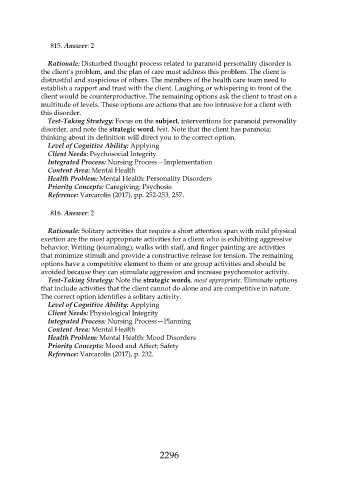Page 2296 - Saunders Comprehensive Review For NCLEX-RN
P. 2296
815. Answer: 2
Rationale: Disturbed thought process related to paranoid personality disorder is
the client’s problem, and the plan of care must address this problem. The client is
distrustful and suspicious of others. The members of the health care team need to
establish a rapport and trust with the client. Laughing or whispering in front of the
client would be counterproductive. The remaining options ask the client to trust on a
multitude of levels. These options are actions that are too intrusive for a client with
this disorder.
Test-Taking Strategy: Focus on the subject, interventions for paranoid personality
disorder, and note the strategic word, best. Note that the client has paranoia;
thinking about its definition will direct you to the correct option.
Level of Cognitive Ability: Applying
Client Needs: Psychosocial Integrity
Integrated Process: Nursing Process—Implementation
Content Area: Mental Health
Health Problem: Mental Health: Personality Disorders
Priority Concepts: Caregiving; Psychosis
Reference: Varcarolis (2017), pp. 252-253, 257.
816. Answer: 2
Rationale: Solitary activities that require a short attention span with mild physical
exertion are the most appropriate activities for a client who is exhibiting aggressive
behavior. Writing (journaling), walks with staff, and finger painting are activities
that minimize stimuli and provide a constructive release for tension. The remaining
options have a competitive element to them or are group activities and should be
avoided because they can stimulate aggression and increase psychomotor activity.
Test-Taking Strategy: Note the strategic words, most appropriate. Eliminate options
that include activities that the client cannot do alone and are competitive in nature.
The correct option identifies a solitary activity.
Level of Cognitive Ability: Applying
Client Needs: Physiological Integrity
Integrated Process: Nursing Process—Planning
Content Area: Mental Health
Health Problem: Mental Health: Mood Disorders
Priority Concepts: Mood and Affect; Safety
Reference: Varcarolis (2017), p. 232.
2296

